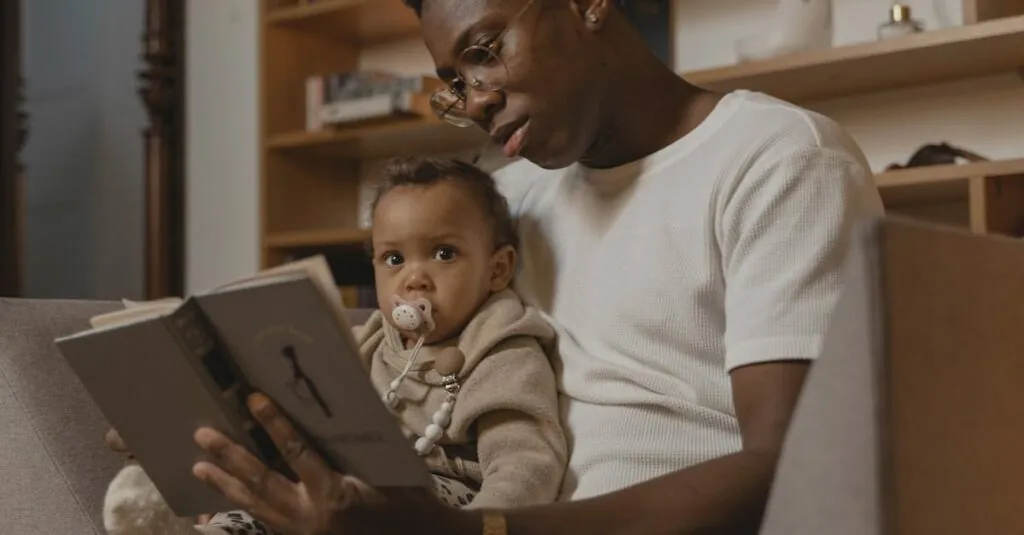Divorce is never a walk in the park, especially when kids are involved. It’s like trying to explain why the sky is blue to a toddler—complicated and a bit messy. But when the time comes to share this news, it’s crucial to approach the conversation with care, honesty, and maybe a sprinkle of humor to lighten the mood.
Navigating this emotional terrain doesn’t have to feel like a scene from a dramatic movie. With the right strategies, parents can make the discussion more manageable and less daunting. By focusing on clarity and reassurance, they can help their kids understand that love doesn’t disappear even when the family structure changes. So grab a comfy chair and a cup of coffee—it’s time to dive into how to tackle this tough conversation with grace and a touch of wit.
Table of Contents
ToggleUnderstanding Divorce
Divorce signifies the legal dissolution of a marriage, impacting family dynamics and emotional well-being. It typically involves separation of assets, living arrangements, and custody decisions. Emotional intensity often accompanies this process, especially for children.
Parents can guide their kids through this complex transition with age-appropriate explanations. The level of understanding varies with developmental stages. Young children may grasp basic concepts, while older kids can handle more nuanced discussions.
Reassurance is crucial during these conversations. Children often fear losing love or support, so parents should emphasize that love remains constant regardless of changes. Kids should hear that relationships evolve and that both parents still care deeply about them.
Effective communication involves clarification of terms. Parents might explain that divorce doesn’t mean they stop being a family. Rather, it transforms the family structure.
Support is vital. Encouraging kids to express feelings helps them process emotions. One-on-one conversations provide opportunities for dialogue, allowing children to voice their concerns or ask questions. Listening attentively fosters trust and openness.
Resources also play a role. Books about divorce tailored for children can provide additional perspectives. Seeking support from counselors can also be beneficial, equipping families with tools to navigate emotional challenges.
Understanding divorce requires patience and empathy. By approaching the topic carefully, parents can help their children adapt to new family configurations while maintaining emotional security.
Preparing Yourself
Preparing for discussions about divorce requires reflection and emotional readiness. Parents must recognize their feelings to approach the conversation effectively.
Acknowledge Your Emotions
Acknowledging emotions is essential before discussing divorce with children. Fear, sadness, and confusion may arise during this process. Parents should accept these feelings rather than suppress them. They can model emotional honesty by expressing how they feel appropriately. By doing so, parents demonstrate that experiencing emotions is natural. This validation fosters a more compassionate atmosphere for children. Setting aside time for personal reflection allows parents to process their emotions. Prioritizing emotional well-being helps in maintaining clarity during tough conversations.
Understand Their Perspective
Understanding children’s perspectives enhances communication about divorce. Each child may react differently based on age, maturity, and personality. Empathy plays a crucial role in recognizing their fears and questions. Parents should ask open-ended questions to encourage dialogue. This strategy provides children a safe space to voice concerns. Listening without judgment is vital for fostering trust. Validating their feelings reassures them that their emotions are important. Keeping in mind that children may feel guilt or blame influences how parents address concerns. Understanding these dynamics ensures a more supportive environment during discussions.
Timing and Setting
Addressing divorce requires careful consideration of when and where to have the conversation with children. Selecting the right moment and environment can greatly impact the discussion.
Choosing the Right Time
Consider moments when children appear relaxed and engaged. Try to avoid busy schedules or stressful periods. Late afternoons or weekends often provide a calmer atmosphere. By ensuring the timing aligns with a child’s emotional state, parents can facilitate open dialogue. Recognizing signs of anxiety or stress in children can guide parents. They should be prepared for questions that may arise, and being responsive to those inquiries fosters trust during this sensitive conversation.
Creating a Safe Space
Creating a comfortable environment is vital for productive discussions about divorce. Establish a setting that feels secure, such as their favorite room or a quiet outdoor space. Soft lighting and familiar surroundings can relax children and encourage honesty. Remaining present and attentive during the conversation shows children that their feelings matter. Avoid distractions like phones or loud noises that might disrupt the moment. Engaging with gentle body language and a calm voice promotes openness. Allowing children to express their emotions freely without interruption encourages understanding and connection.
Delivering the Message
Delivering the message about divorce to children requires sensitivity and clarity. Parents must focus on their child’s understanding while navigating this complex topic.
Using Age-Appropriate Language
Age-appropriate language ensures children grasp the situation and feel secure. Younger children may need simple phrases like “Mom and Dad are going to live in different homes.” Clear terminology helps minimize confusionand makes the message more relatable. For older children, more detailed explanations are suitable, addressing their emerging emotional capacity. Parents should explain why the divorce is happening without placing blame. This fosters a sense of security while respecting their child’s ability to comprehend difficult concepts.
Encouraging Questions
Encouraging questions provides children with an opportunity to express their thoughts and feelings. Parents should invite their kids to ask anything, reassuring them that their questions are valid. Responses should be honest yet gentle, maintaining an open dialogue. Listening attentively demonstrates that their feelings matter. Parents can say, “It’s okay to feel sad or angry” to validate emotions. Regularly providing spaces for children to share their concerns enables them to process the change more effectively. Active engagement during discussions improves trust and helps children feel supported throughout the transition.
Supporting Them After the Announcement
Supporting children after announcing a divorce requires ongoing communication and reassurance. Parents play a crucial role in helping their kids navigate their emotions during this challenging time.
Emotional Check-ins
Regular emotional check-ins foster connection and understanding. Parents can initiate these conversations by asking simple questions, like how their children feel about the changes. Expressing that it’s okay to feel a range of emotions, including sadness or confusion, encourages children to open up. Sharing feelings creates a safe space for dialogue. Observing signs of distress, such as changes in behavior or mood, also signals when to provide extra support. Engaging in active listening without judgment strengthens trust. Children benefit when parents remain patient and empathetic, reinforcing their value of open communication.
Adjusting to New Routines
Adjusting to new routines becomes essential for children following a divorce. Establishing consistent schedules helps create stability and predictability. Parents can outline daily activities, like school routines, mealtimes, and family outings, to provide a sense of normalcy. Proactively including children in discussions about changes promotes collaboration and fosters resilience. Encouraging family traditions, like movie nights or game evenings, builds lasting connections even amidst transitions. Flexibility also plays a role, allowing room for adjustments as needed. Emphasizing that both parents remain present and involved further supports emotional stability, helping children feel secure in their new family structure.
Navigating the conversation about divorce with children requires sensitivity and understanding. Parents play a crucial role in ensuring their kids feel secure and loved throughout this transition. By using age-appropriate language and encouraging open dialogue, parents can help their children process their emotions and adapt to new family dynamics.
It’s essential to provide ongoing support and reassurance, allowing children to express their feelings freely. Creating a safe environment for discussion and maintaining consistent routines can significantly ease the emotional impact of divorce. Ultimately, with patience and empathy, parents can guide their children through this challenging time, fostering resilience and emotional well-being.








